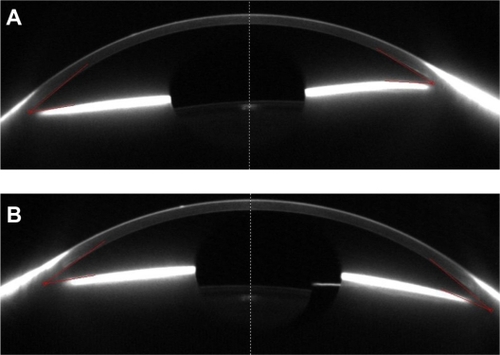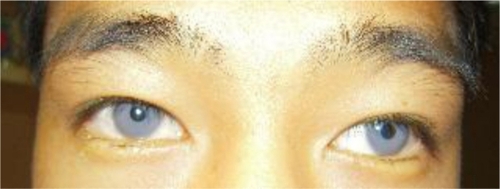Abstract
Purpose:
To provide a literature review of implant related complications from bilateral NewColorIris implantation (Kahn Medical Devices, Panama City, Panama).
Methods:
A PubMed search of peer-reviewed ophthalmology journals for complications related to NewColorIris implants was performed.
Results:
Including a recent case published by the authors, a total of nine patients (18 eyes) with management of complications such as endothelial cell loss, elevated intraocular pressure (IOP), corneal edema, anterior chamber inflammation, decreased visual acuity, and cataract formation were reviewed.
Conclusions:
Sight-threatening complications including corneal decompensation, IOP elevation, uveitis, and hyphema have been described after NewColorIris implantation.
Introduction
For the purposes of cosmetic eye color change, NewColorIris (Kahn Medical Devices, Panama City, Panama) silicone prosthesis implants were developed in 2004.Citation1 Although not approved by the Food and Drug Administration (FDA), implantation has been performed with subsequent complications noted in the literature, including endothelial cell loss, elevated intraocular pressure (IOP), corneal edema, anterior chamber inflammation, decreased visual acuity, and cataract formation.Citation2–Citation8 While not specific to the NewColorIris, placement of phakic intraocular lenses have been associated with posterior segment complications, such as giant retinal tears.Citation9
In recent years, NewColorIris implants have been removed following the development of acute and chronic side effects.Citation2–Citation4,Citation6–Citation8,Citation10 This paper summarizes the published cases of complications arising from NewColorIris implantation for cosmesis in phakic eyes.
Results
was compiled from a PubMed search of peer-reviewed ophthalmology journals. To our knowledge, only eight cases (16 eyes) with complications following NewColorIris cosmetic implantation surgery had been published prior to the submission of our recent case.Citation2–Citation9 Of the nine known cases (18 eyes) including our own, six of the nine (66.7%) involve female patients. The only available long-term safety data comes from the manufacturer, which studied twelve female patients (24 eyes) with a mean endothelial cell density loss of 2.6% after eight months of follow-up.Citation1 In this series, only one patient (two eyes) required explantation due to uveitis and ocular hypertension. Our review summarizes nine cases (18 eyes), including one new bilateral case encountered by us that together suggest a need for more information regarding the long-term safety of NewColorIris implantation.
Table 1 Cases of NewColorIris implantation for cosmesis
Symptomatic patients can be stratified into early (<1 month) or late (>6 months) symptom onset, with seven of nine cases (77.8%) presenting in the first postoperative month. Several of these patients reported immediate complications including hyphema, elevated intraocular pressure, and blurred vision.Citation2,Citation6 Others were asymptomatic in the immediate postoperative period, but developed complaints in the following weeks.Citation4,Citation5,Citation8 The most common complaint amongst early and late presenters was decreased visual acuity/blurred vision, which was present in all nine patients (18 eyes, 100%). At last follow-up, nine of the 16 eyes (56.25%) had decreased best corrected visual acuity (BCVA), which is the same number of eyes with sub-optimal BCVA at presentation ().
In the early presentation cohort, only one of 14 eyes (7.1%) displayed hyphema, which resolved after anterior chamber paracentesis and two 25 mcg tissue plasminogen activator (tPA) injections.Citation2 A proportionately higher two of four eyes (50%) in the late presentation group developed hyphema, which resolved with conservative pharmacological management.Citation3 Corneal edema and elevated intraocular pressure were more common findings, occurring in 13 of 16 eyes (81.25%) and 12 of 16 eyes (75%), respectively (). Exam findings were not available for one patient.Citation7 All published cases indicate anterior chamber inflammation visible by slit-lamp exam.
Several patients required surgery in addition to explantation. These procedures included: three trabeculectomies for IOP management, two Descemet Stripping Automated Endothelial Keratoplasties (DSAEK), and three peripheral iridotomies, two of which were performed by the implant surgeon.Citation2,Citation3,Citation6,Citation7 Hull et al, in their case report of a 27-year-old female who presented with a large peripheral iridotomy, contended that their patient’s account of acute pain upon implantation suggests that the iridotomy was performed intraoperatively in response to iris-prolapse.Citation6 Aside from the aforementioned procedures, one other patient was undergoing evaluation for Descemet’s stripping endothelial keratoplasty (DSEK) secondary to ongoing corneal edema at last follow-up.Citation2
Discussion
In order to better understand the pathogenesis of the numerous complications seen in NewColorIris-implanted eyes, it is helpful to consider reported irregularities in the implants themselves. Several case reports in the literature identify manufacturing defects that likely contribute to implant dysfunction. In one such study, scanning electron microscope (SEM) images revealed surface irregularities and sharp edges that may contribute to the abrasion of the corneal endothelium and iris.Citation4 Concerns about the implant’s peripheral footplates have also been documented. According to the manufacturer, these footplates are responsible for minimizing the implant’s interaction with the trabecular meshwork.Citation11 However, Anderson et al report that four of six footplates were missing from one of the explanted prostheses in their case report. They suspect that part of the implant had been hand-cut, resulting in significant edge irregularity.Citation2 Several authors have also demonstrated a tendency of the NewColorIris implant to directly contact the angle structures.Citation3,Citation4,Citation8 Pentacam images of our patient similarly illustrate the implant’s close proximity to the iris and angle (). These prostheses not only impinge on the angle structures, but shift position with time. Our patient displayed a temporally-shifted implant (), while another case in the literature describes a nasally-decentered presentation. Other authors have published images demonstrating improperly-sized implants that exhibit vaulting within the anterior chamber.Citation2
Figure 1 Pentacam image showing a silicone NewColorIris implant in the anterior chamber in the (A) right eye, with close apposition with the angle and (B) left eye, with asymmetry within the anterior chamber relative to the angle.

Figure 2 Patient with blue NewColorIris implants OU. Note the temporal displacement of the left implant with a decentered light reflex.

The pathogenesis of the IOP increases commonly seen in these patients may be multifactorial. In light of microscopic images showing pigment-laden macrophages and direct pigment deposition on the surface of the implant, some authors have attributed the rise to iris pigment liberation.Citation2,Citation6,Citation8 Others have cited the implant’s direct contact with angle structures.Citation2–Citation4,Citation6,Citation8 Explantation is an effective means of controlling elevated IOP, but some patients may require long-term postoperative pharmacotherapy.Citation2
In some cases, explanted eyes suffered insults that may lead to future complications. Our patient, like the one presented by Thiagalingam et al, developed bilateral premature sclerotic changes in his native lenses.Citation8 A 30-year-old female described by Castanera et al experienced visual field deficits in her follow-up period.Citation4 Other eyes were found to have significant corneal decompensation.Citation2,Citation3,Citation5,Citation8 Due to the high likelihood of postexplantation sequelae in these patients, they should receive long-term follow up with IOP, BCVA, endothelial cell counts, specular microscopy, and gonioscopy.
Steps should be taken to select appropriate candidates for artificial iris implantation. Currently, no criteria for candidacy have been established. While anterior chamber depth and baseline endothelial cell density should be evaluated, close attention must be given to the dimensions of the cornea at the limbus. Given the asymmetry of the horizontal and vertical meridians of the cornea, the anterior chamber would not uniformly support a perfectly circular implant. Furthermore, a detailed and careful evaluation of the iris must be performed. The eccentricity of the pupillary aperture should be assessed. Evaluation of the configuration of the iris root by imaging modalities could reveal variants such as plateau configuration, which would increase the risk of iris chafing. Specific measurement of each individual patient’s anatomy may permit custom sizing of the implant in the future, with decreased associated risk of complications. Nevertheless, if preoperative evaluation suggests a patient may be a good candidate for an elective NewColorIris implant, this procedure currently has no proven safety record and may result in urgent explantation and long-term sight-threatening sequelae.
Although it is difficult to estimate the extent of complications as it is unknown how many NewColorIris implants have been implanted, review of the literature reveals vision-threatening complications such as elevated IOP, intraocular inflammation, and corneal decompensation. With its current design, implantation should be seriously deliberated and risks such as possible surgery for cataracts, elevated IOP, and explantation should be extensively discussed with potential patients.
Acknowledgements
This project was supported by the Research to Prevent Blindness foundation, New York, NY, USA.
Disclosure
No conflicts of interest were declared in relation to this paper.
References
- KahnDALiakopulosPNew cosmetic artificial iris diaphragm implant (Newiris): 8 months follow-upPresented at the Joint Meeting of the American Academy of Ophthalmology and the European Society of Ophthalmology102004
- AndersonJEGrippoTMSbeityZRitchRSerious complications of cosmetic NewColorIris implantationActa Ophthalmol201088670070419493251
- ArthurSNWrightMMKramarevskyNKaufmanSCGrajewskiALUveitis-glaucoma-hyphema syndrome and corneal decompensation in association with cosmetic iris implantsAm J Ophthalmol2009148579079319660735
- CastaneraFFuentes-PáezGTenPPinallaBGuevaraOScanning electron microscopy of explanted cosmetic iris implantsClin Experiment Ophthalmol201038664865120456447
- Garcia-PousMUdaondoPGarcia-DelpechAAcute endothelial failure after artificial iris-lens diaphragm implantation (NewIris) for cosmetic purposesAmerican Academy of Ophthalmology Poster presentation2006
- HullSJayaramHMearzaAAComplications and management of cosmetic anterior chamber iris implantsCont Lens Anterior Eye201033523523820382066
- MacDonaldLCosmetic iris implants – is vanity worth losing your vision?Optometry J Am Optometric Assoc2010816281282
- ThiagalingamSTarongoyPHamrahPComplications of cosmetic iris implantsJ Cataract Refract Surg20083471222122418571095
- GeorgalasIPetrouPPapaconstantinouDKoutsandreaCLadasIBilateral giant tear-associated retinal detachment following Artisan phakic intraocular lens implantation for correction of moderate myopiaActa Ophthalmol2010884e143e14419549101
- SikderSDavisSWPatelVPHolzHMoshirfarMComplications and management of NewColorIris implantation in phakic eyesJ Refract Surg2011In press.
- GrovesNKahnDADiaphragm implant safely changes color of irisOphthalmol Times200541572